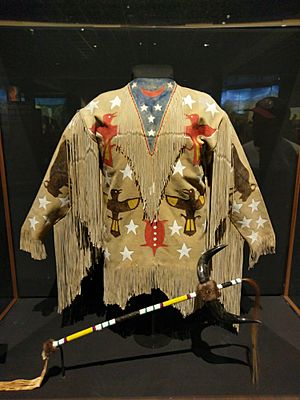Ghost shirt facts for kids
Ghost shirts were special clothing, often shirts, worn by followers of the Ghost Dance religion. People believed these clothes had strong spiritual powers. This religion was started in the late 1800s by a Northern Paiute Native American named Wovoka (also known as Jack Wilson). The Ghost Dance quickly became popular among many Plains tribes.
Some groups, especially the Lakota people, believed that Ghost shirts could protect them from bullets through spiritual power. Wovoka, the founder of the Ghost Dance, actually taught that people should be peaceful and not fight against the white settlers. He thought that if Native Americans lived peacefully, they would be freed from oppression, perhaps through natural events like earthquakes.
However, two Lakota warriors who followed Wovoka, Kicking Bear and Short Bull, had a different idea. They believed the Ghost shirts would protect wearers enough to fight back against the U.S. military. Sadly, the shirts did not offer this protection. When the U.S. Army attacked at the Wounded Knee Massacre in 1890, 153 Lakota people died, 50 were wounded, and 150 went missing.
A researcher named James Mooney suggested that the idea of Ghost shirts stopping bullets might have come from the Mormon temple garment. Mormons believe these garments protect people who are religious, but not from bullets. Scholars think that in 1890, Chief Kicking Bear introduced this idea to his Lakota people.
Ghost Shirts in Stories
In Kurt Vonnegut's book Player Piano, a group that fights against a very strict, machine-controlled future United States calls itself the Ghost Shirt Society. The people who started this group said they were like the Native Americans from the late 1800s, "making one last fight for the old values."
See also
- The Ghost Shirt, a ghost shirt returned to the Lakota by Glasgow City Council in 1998
- The followers of the Chinese Boxer Rebellion (1899–1901) claimed that the spirits protected them from bullets.
- Detente bala, an inscription used by Spanish soldiers from the 18th century onwards as a protection from bullets.
- Talismanic shirt



